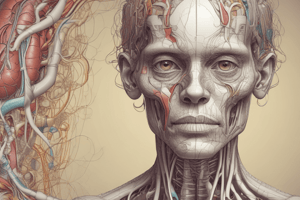Podcast
Questions and Answers
What is responsible for sending messages to the brain about muscle contraction?
What is responsible for sending messages to the brain about muscle contraction?
- Myelin sheath
- Nerves (correct)
- Axon hillock
- Nodes of Ranvier
Which system brings air containing oxygen into the lungs and removes carbon dioxide from the bloodstream?
Which system brings air containing oxygen into the lungs and removes carbon dioxide from the bloodstream?
- Muscular System
- Skeletal System
- Nervous System
- Respiratory System (correct)
What is the role of the digestive system in the body?
What is the role of the digestive system in the body?
- Breaking down food into molecules for absorption (correct)
- Transporting oxygen around the body
- Regulating body temperature
- Sending messages to the brain
Which part of a neuron stores chemicals in granules?
Which part of a neuron stores chemicals in granules?
What happens to particles after they pass through the large intestine in the digestive system?
What happens to particles after they pass through the large intestine in the digestive system?
What is the main function of the skeletal system?
What is the main function of the skeletal system?
Which of the following is responsible for producing blood cells in the body?
Which of the following is responsible for producing blood cells in the body?
What type of muscles control involuntary body functions?
What type of muscles control involuntary body functions?
Which system works alongside the skeletal system to enable voluntary movements?
Which system works alongside the skeletal system to enable voluntary movements?
What is the main function of the nervous system?
What is the main function of the nervous system?
Flashcards are hidden until you start studying
Study Notes
The human body is a complex structure composed of various systems working together to ensure its proper functioning. These systems can be broadly classified into two main categories: the organ systems and the supporting structures. Here's an overview of five key systems in our bodies:
Skeletal System
The skeleton provides support, protection, movement, and storage of minerals such as calcium. It consists of bones, joints, cartilage, tendons, ligaments, and muscles. Bones function like levers, allowing us to move by contracting muscles attached to them. They also contain bone marrow responsible for producing blood cells. Joints allow bones to connect with each other, providing flexibility. Cartilage acts as cushioning between bones and reduces friction during movement. Muscles contract under nerve stimulation and generate force, thus moving bones. Ligaments attach one bone to another, offering stability while still enabling motion. Tendons join muscle to bone, transmitting forces generated by muscles.
Muscular System
Muscles enable voluntary movements and maintain posture. They work alongside the skeletal system, which provides attachment points called insertions. There are three types of muscles: smooth, cardiac, and striated. Smooth muscles control involuntary body functions without conscious effort, while heart muscles pump oxygen through blood vessels. Striated muscles produce fast contractions that move limbs and digits. Muscle fibers contract when nerves signal their contraction. This contraction happens because of chemical reactions within the muscle fibers. Nerves send messages to the brain telling it what is happening.
Nervous System
Nerve messages travel from receptors where they start out to effector organs. The nervous system processes information received by sensory receptors and sends this information along specialized paths directing the actions of motor units. A neuron has dendrites, soma (body), axon hillock, initial segment, myelin sheath, nodes of Ranvier, terminal endings, synaptic knobs, presynaptic membrane, postsynaptic membrane, and interneuron. Neurons communicate via electrochemical signals sent across junctions. Some neurons store chemicals in granules. Most neurons occur singly. Others form networks.
Respiratory System
The respiratory system brings air containing oxygen into your lungs, removes carbon dioxide from your bloodstream, and transports it back to your tissues where more oxygen is needed. The process involves four parts: nose, mouth, trachea, bronchioles, and lungs. When you breathe in, air travels down your throat past your voice box and into your windpipe, where it splits into branches, known as bronchi. Each branch leads to smaller tubes - bronchioles - which eventually lead to tiny air sacs inside your lungs. Oxygen enters these sacs, diffuses across the tissue lining, and gets absorbed into the bloodstream. Carbon dioxide diffuses out of red blood cells and into the alveoli where it mixes with fresh blood coming from the heart. Then, it moves up toward your nose and mouth again.
Digestive System
The digestive system includes all the organs involved in breaking down food into molecules small enough to enter the bloodstream and nourish the body. As we eat, food goes into our mouth and travels down the esophagus to our stomach where gastric acid breaks it apart further. Particles exit the stomach via peristaltic waves and go into the duodenum, where bile from the liver dissolves fats and acids neutralize the remaining stomach acid. The remaining particles pass through the large intestine and then excrete waste products. The digestive tract ends at the rectum, which stores feces until they leave your body.
Each system plays crucial roles in maintaining good health and wellbeing. Understanding how they interact helps us appreciate the complexity of the human body and its remarkable ability to perform daily tasks efficiently.
Studying That Suits You
Use AI to generate personalized quizzes and flashcards to suit your learning preferences.




